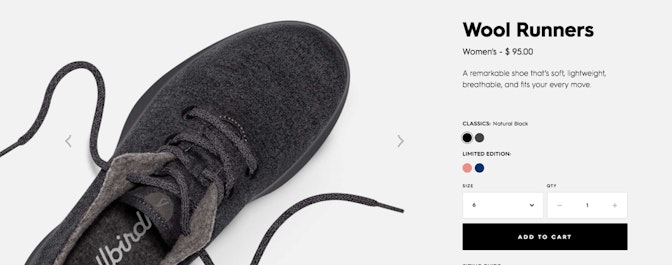Starting a dropshipping business is an excellent way to dip your toes into the world of entrepreneurship. It allows you to sell products without needing to stock inventory or make upfront payments. And with dedication and hard work, this business model can lead to a steady income over time.
This complete dropshipping guide details essential business and financial steps to consider. Some steps are necessary from the beginning, while others are beneficial. Considering them early on will save you time and headaches down the road.



What is a dropshipping business?
Dropshipping is a business structure that allows you to operate your store without holding any inventory. Once you’ve made a sale, your supplier will ship the products from their warehouse directly to your customer’s doorstep. This eliminates the hassle of storing, packaging, and shipping products yourself.
How does the dropshipping business model work?
Dropshipping is an order fulfillment model that enables online stores to sell products to consumers without holding any inventory. When a customer buys a product from their catalog, a third-party supplier ships it directly to them.
The selling process involves setting a retail price higher than the wholesale price you pay the supplier, with the difference being your profit. There’s no need to handle products directly or invest in inventory.
→ Click Here to Launch Your Online Business with Shopify
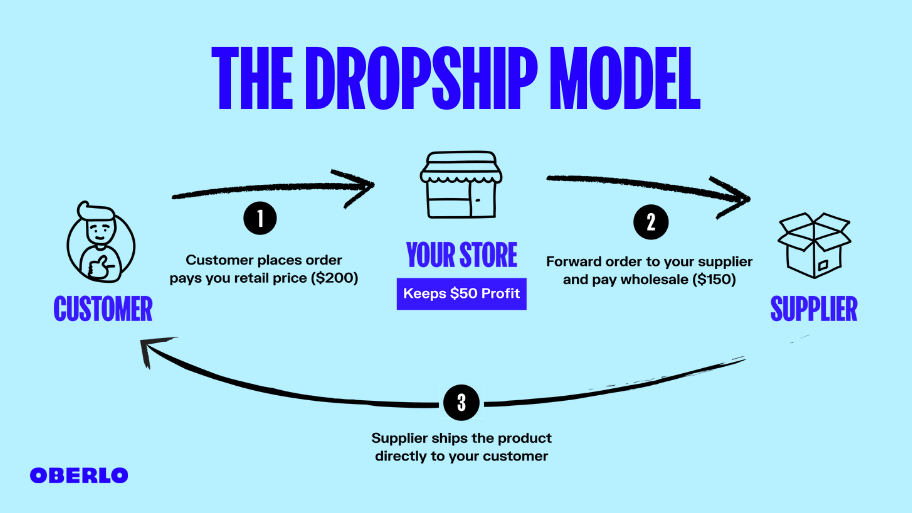
To start selling, you only need to set up an account with a supplier.
To find suppliers for your dropshipping business, you have three main options:
- Supplier databases. Platforms like Alibaba or AliExpress enable you to find a diverse array of suppliers.
- Integrated supplier directories. Tools such as DSers directly integrate with your store’s back end, simplifying the process of browsing and selecting suppliers.
- Print-on-demand services. Services like Printify give you access to a network of print-on-demand suppliers who can customize products with your designs upon order.
The simplest dropshipping method for Shopify store owners is using DSers. It lets you find and add millions of AliExpress products to your store with one click.
In dropshipping, your tasks include developing your website and brand, selecting and promoting your products, handling shipping costs, and setting prices that ensure profitability.
What are the advantages of dropshipping?
A dropshipping business is a profitable business model where you only pay for the products that you sell. This means you’re not burdened with the cost of creating products or carrying inventory. As such, the startup costs of running a dropshipping store are quite low compared to those that come with operating a standard ecommerce business.
In this business model, you also avoid the costs of maintaining unsold inventory and employing staff for packaging and shipping products. While it will require daily work when it comes to processing orders, most of the order processing steps are automated and only require the click of a button. The dropshipping business opportunities are endless—you just need to take the first step.
How to start a dropshipping business: The 8-step dropshipping business plan
1. Choose a dropshipping business idea

The first step in launching a dropshipping business is comprehensive market research. It’s akin to evaluating different aspects like location, competition, and market trends when opening a retail store. Your aim should be to explore a niche that not only interests you but also holds profitability potential.
Products catering to specific niches often attract a dedicated and passionate customer base. As such, it’s easier to sell them and generate higher profit margins for your dropshipping business.
Examples of niche dropshipping products include:
- Handcrafted leather wallets for minimalist enthusiasts
- Organic skin care products for eco-conscious consumers
- Customized meal prep containers for health-conscious individuals
- Sustainable fashion accessories for trendsetting shoppers
By focusing on niche and trending items, you can catch the eye of potential customers and gain momentum without facing off against larger, more established ecommerce brands.
There are a few tools and tactics you can use to validate your dropshipping business ideas:
- Google Trends. Google Trends is a valuable tool for learning about product trends. It provides insights into whether an item is trending upward or downward over time, as well as the seasons when it tends to be most popular. Although you don’t see the search volume for a specific term, you get enough data to conduct keyword analysis and assess the product’s popularity in search.
- DSers order volume. DSers lets you search for products based on order volume. A higher order volume indicates a stronger demand and potential success for your business idea.
- Keywords Everywhere. Keywords Everywhere reveals monthly search counts and competition level for your products. This data helps you understand your dropshipping idea’s popularity and can spark ideas for future products.
2. Do competitor research

Once you have decided what to sell, you now need to educate yourself on who your competitors are, what they sell, and how they sell their products. Market research is an essential part of this step, and there are many ways to do it.
- Run a Google search. Search engines are a clear starting point for mapping out your competition. Enter key terms related to your niche to see who you’re up against. For example, if you’re selling eco-friendly water bottles, enter terms like “sustainable water bottles” into Google. Examine the companies that appear in the search results and study how they promote their products. If targeting a specific geographical area, utilize tools such as Ahrefs or Semrush to get keyword data related to those regions.
- Browse social media. Look for Facebook ads related to what you sell and note the top brands. See how they talk to customers, how they design their pages, and how much people interact with them. You might even follow them to keep up with their posts. Use what you learn to make your business more visible and improve your approach to social media marketing.
- Use competitor spy tools. Online tools like Similarweb are invaluable for tracking your competitors’ online presence. Use them to get a detailed snapshot of competitor website information, including their visitor counts, main traffic sources, social media engagement, and main competitors. This information can help you strategize and position your business more effectively.
Study your main competitors thoroughly: website, pricing, marketing strategies, product details, and reputation. Organize this research in a spreadsheet for quick reference when deciding on your store’s strategy.
3. Find a dropshipping supplier
Suppliers are the backbone of a successful dropshipping business. They ensure the store has a steady supply of products, handle shipping directly to customers, and maintain the quality and availability of merchandise.
Ecommerce platforms like Shopify make it easy to find dropshipping suppliers. Once you’ve created an online store, install the DSers app to find potential suppliers for your business.
DSers is a marketplace for dropshipping suppliers to showcase their products. It features a wide range of items, including toys, electronics, and women’s apparel. You can add any product to your store with one click and benefit from automated order forwarding to suppliers. Best of all, getting started is completely free.
The DSers app connects to AliExpress to give you easy access to a wide range of products for your store. On the DSers product page, you can find detailed information on product quality and shipping times, or learn more about a supplier.
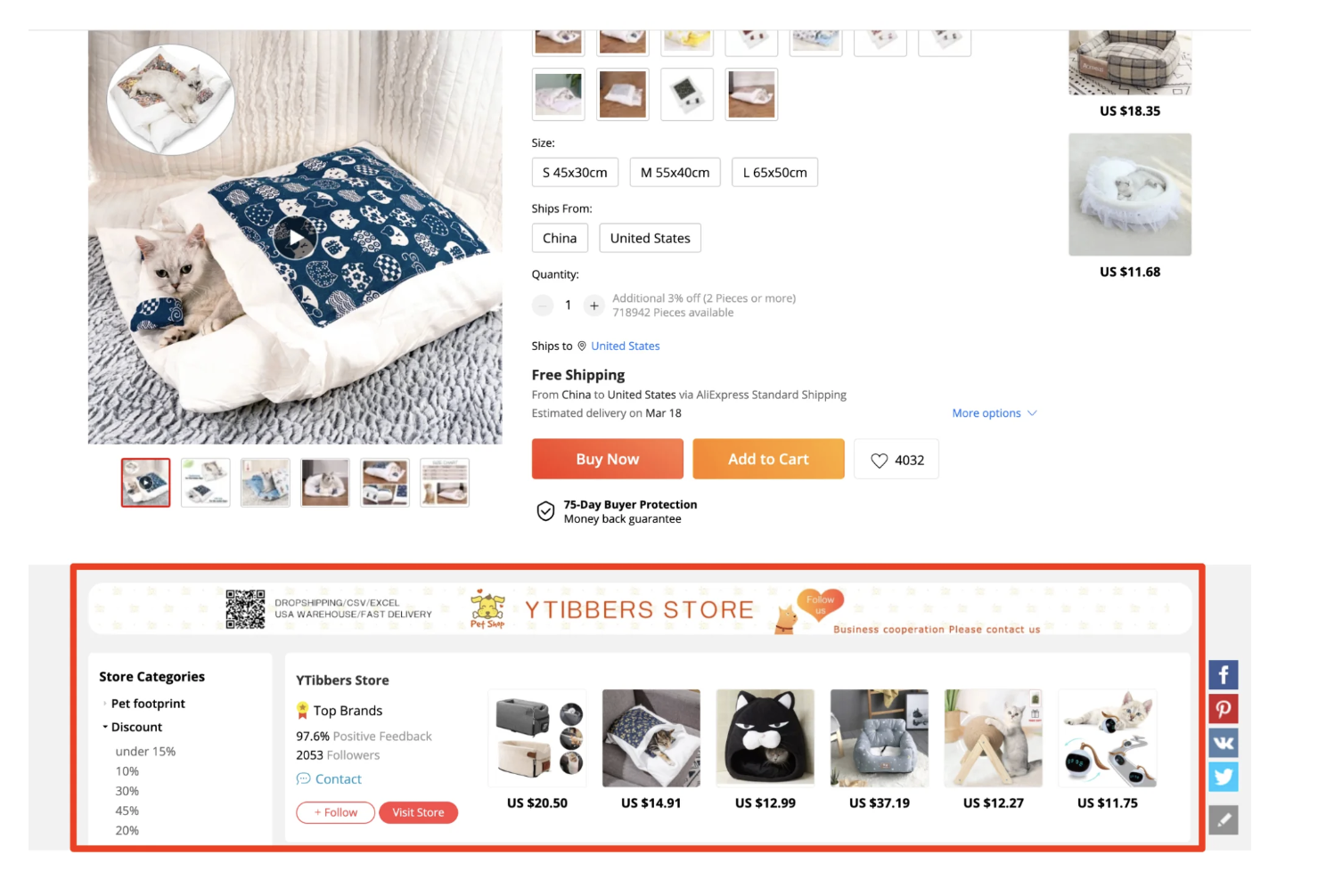
Clicking on a supplier’s link redirects you to their AliExpress page. There, you can find customer reviews and their top-selling items.
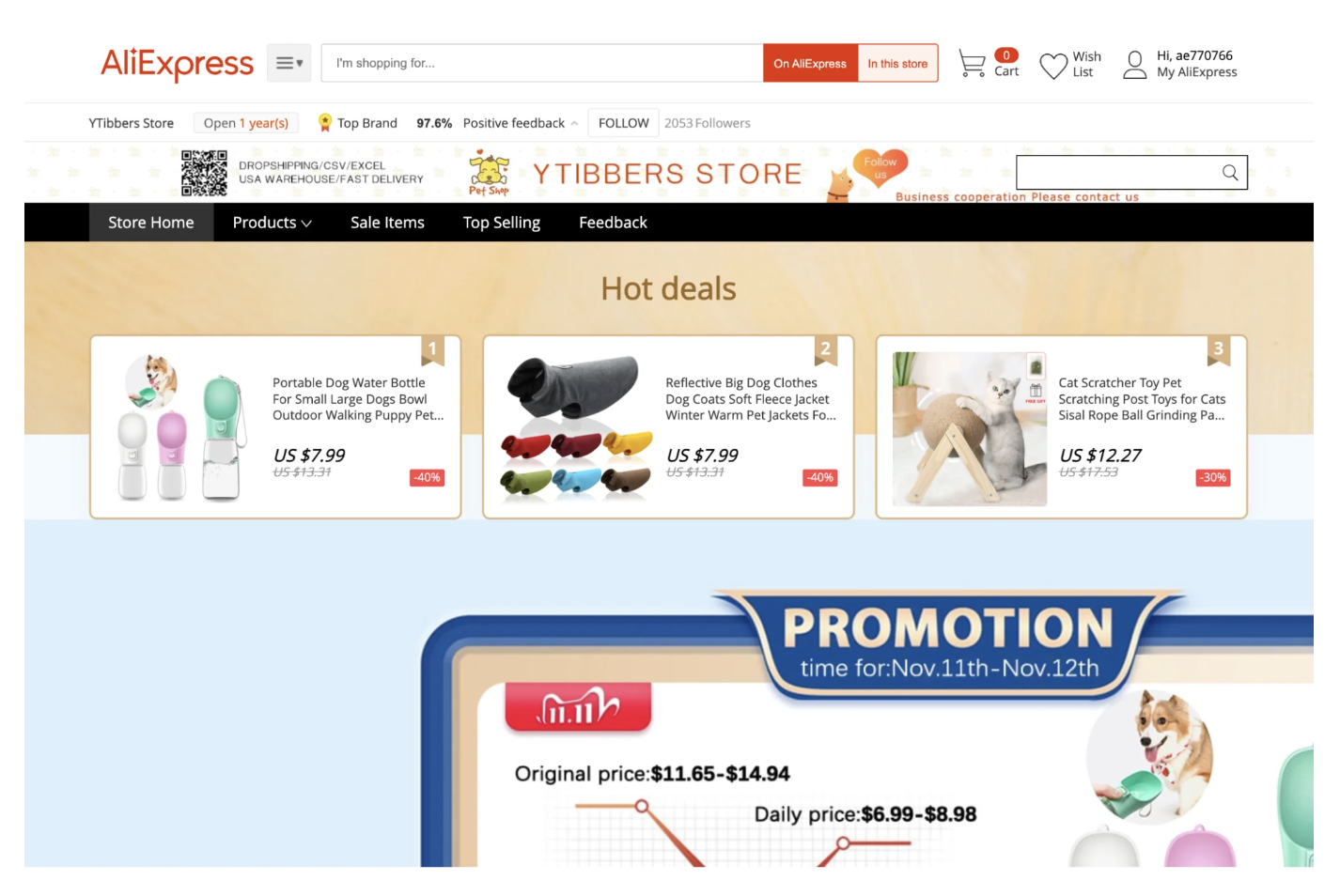
On the DSers suppliers page, remember to select products with ePacket shipping if your supplier is based in China.
ePacket is an efficient and affordable shipping method from China to countries like the US, the UK, and Canada. Instead of waiting months, your customers can receive their packages in up to two weeks, for just a few dollars.
4. Set up your dropshipping store
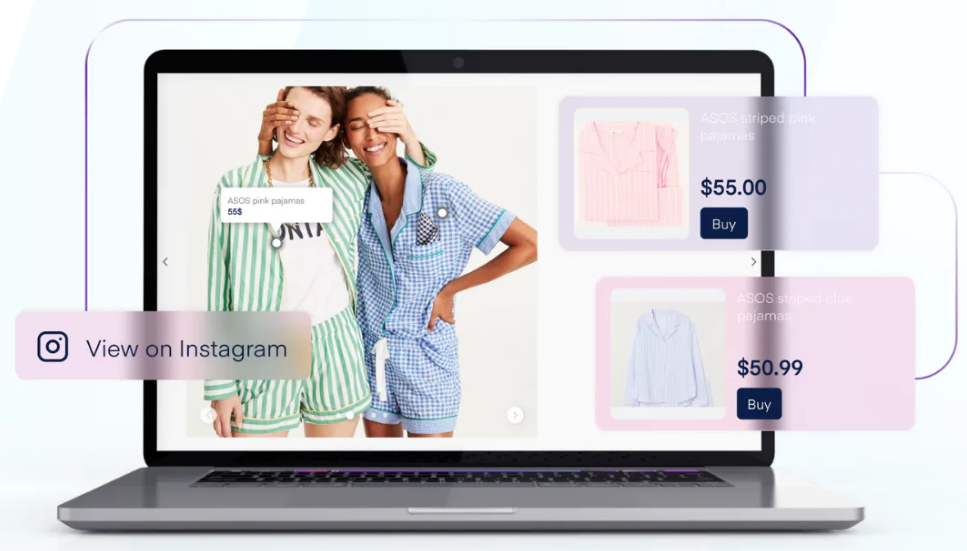
There are a few components to building a dropshipping business store the right way:
Domain name
Your domain name is especially important if you’re building a long-term brand. You can use a free business name generator to simplify the process. Always opt for a .com domain, regardless of your niche. If you want your niche to be a keyword in your new domain, make sure it’s broad—like “beauty,” “jewelry,” or “fashion”—rather than specific. This way, you won’t need to change your domain name down the road.
Ecommerce platform
Shopify is the most comprehensive ecommerce platform on the market. With new features, tools, resources, and apps being added regularly, you’ll find it easy to run a business on the platform. Plus, Shopify connects with print-on-demand services, should you choose to diversify your dropshipping approach
Theme
As a Shopify user, you get access to free themes. One of these is Minimal Motion. It offers a clean and user-friendly interface, perfect for those just starting out with store design. As your store begins to generate revenue, consider upgrading to a premium theme to further improve your store’s appearance.
Dropshipping app
To manage your inventory and place orders efficiently, you’ll need a reliable dropshipping app. DSers is a solid choice that allows you to explore products in a variety of popular niches. When starting out, it’s advisable to focus on 10 to 25 products, as writing descriptions for a larger inventory can become overwhelming. If you have questions or need guidance, you can turn to the DSers blog, its social media pages, or Shopify’s own support line.
5. Decide on a business structure

If you’re dedicated to your project, consider creating an official business entity. Though we aren’t legal advisers and cannot give legal guidance, we can outline three common types of business structures for you:
Sole proprietorship
This is the simplest form of business structure, but it lacks personal liability protection. If your business is sued, your personal assets could also be at risk. The filing requirements are minimal, and you just include your business’s income on your personal tax returns. There are no additional state or federal business filings required.
Limited liability company (LLC)
Most dropshipping companies prefer forming an LLC. This structure better protects your personal assets by recognizing your business as a separate legal entity. Although the liability protection isn’t perfect, it’s stronger than that of a sole proprietorship. You’ll need to meet more filing requirements and pay both incorporation and ongoing fees.
Related: Sole proprietorship vs. LLC: A Breakdown
C corporation
Most major corporations are established as C corporations, which offer the greatest liability protection when set up correctly. However, they are more expensive to start and C corps face double taxation, where the business’s income is taxed at both the corporate level and again as it is distributed to shareholders.
You’ll want to consult with a lawyer before making any incorporation decisions. These professionals know the ins and outs of each structure and can help you choose the ideal one for your dropshipping business.
Request an EIN number
You’ll need an employer identification number (EIN) number, which the IRS requires every business to have one. It works like a Social Security number, but for your business. You need it to file taxes, sign up for wholesale dropshipping accounts, open a bank account, and do other business tasks.
The good news is, getting an EIN number is simple and doesn’t cost anything. You can apply for it online.
6. Market your dropshipping business

You’ve selected your products and set up your store. The next step is to market your dropshipping business.
This is a crucial component of any dropshipping business plan. For those just starting out and likely on a tight budget, it’s worth noting that effective marketing doesn’t have to be expensive. Here are some methods to explore:
Facebook and Google ads
Facebook ads tap into the impulse to buy, are scalable, and can highlight your products well. Google Shopping Ads allow targeting of long-tail keywords to attract ready-to-purchase shoppers. You can test both platforms to see which advertising method leads to better results for your business.
Influencer marketing
If you’re just starting and have a tight budget, influencer marketing is a cost-effective way to reach your audience. People often trust influencers more than traditional ads. Instead of paying influencers a fixed amount, consider a deal where they earn for every sale they bring. This method is more affordable for you and rewarding for them.
Content creation
To keep visitors coming to your store, start creating content. Launch a blog focused on your niche. Aim to both entertain and educate your audience. Other options include making YouTube videos, creating infographics, or starting a podcast to raise awareness of your brand.
Community engagement
Join groups passionate about your niche. Start discussions with potential customers on Reddit, Facebook groups, or forums. Focus on being helpful, not just selling. This approach builds trust and makes people more likely to buy from your brand.
Email marketing
Email marketing is a powerful tool for building long-lasting relationships with customers and driving repeat purchases. Consider sending personalized content, such as product recommendations, promotional offers, and informative newsletters, to increase engagement and boost sales.Shopify Inbox is available at no cost for managing these communications in your Shopify store.
7. Streamline your finances

Starting your own dropshipping business comes with a crucial financial management step: separating personal and business finances. Mixing these can lead to confusion, complicate accounting, risk personal assets, and attract IRS scrutiny during audits.
Creating distinct accounts for your business is the best practice. This includes:
Business checking account
This account should handle all your business transactions. All business income goes in, and expenses come out, streamlining your accounting processes.
Business credit card
Opt for a credit card dedicated to business expenses, especially useful for buying dropshipping inventory. Choosing a rewards card can earn you significant benefits from frequent supplier purchases.
Sales tax collection
You need to collect sales tax if your state requires it and you sell to someone in your state. For sales outside your state, current laws may exempt you from collection, but keep an eye on potential legal changes.
If collecting sales tax is necessary, register with your state’s department of commerce as an online retailer to understand your obligations.
Local business licenses
Many places require a business license, which might vary for home-based businesses. Research your local requirements to ensure compliance.
Incorporating outside the United States
For international merchants aiming to enter the US market, setting up a business in the United States is possible but requires understanding and fulfilling specific legal requirements. This might involve traveling to the US, partnering with someone in the country, or hiring an agency to manage the setup.
8. Test and optimize
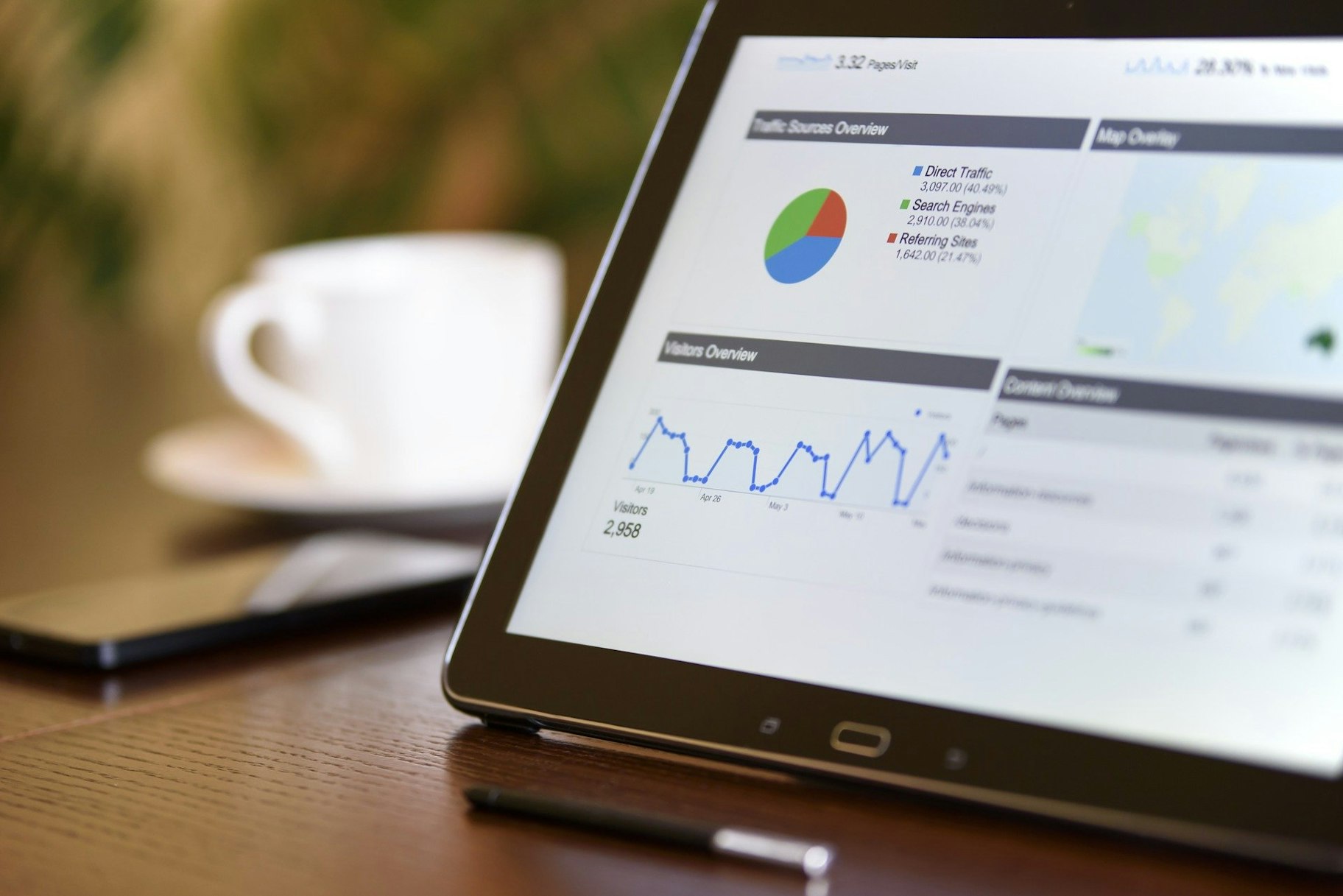
Once you’ve spent time building your website, brand, and marketing, you can start to analyze the results of your hard work. You may find that certain marketing activities are hugely successful, while others not as much. You can also compare your prices to that of your competition and see if you could make things more competitive.
You can use tools like Google Search Console or Google Analytics to evaluate your online traffic and make sure it’s increasing, not decreasing. If you’re using third-party tools for email marketing or social media reporting, set up weekly or monthly automatic reports to remind you to analyze this information regularly. Even a quick snapshot of data from a tool can be enough to decide if a campaign is working or not.
Overall, the most important part of a successful online ecommerce store is to test and optimize. This ensures that your website will not fall behind best practices and keeps you ahead of your competitors.
Where to find dropshipping businesses for sale?
If you don’t want to build a Shopify dropshipping business from scratch, you can easily find a dropshipping business for sale on Flippa.
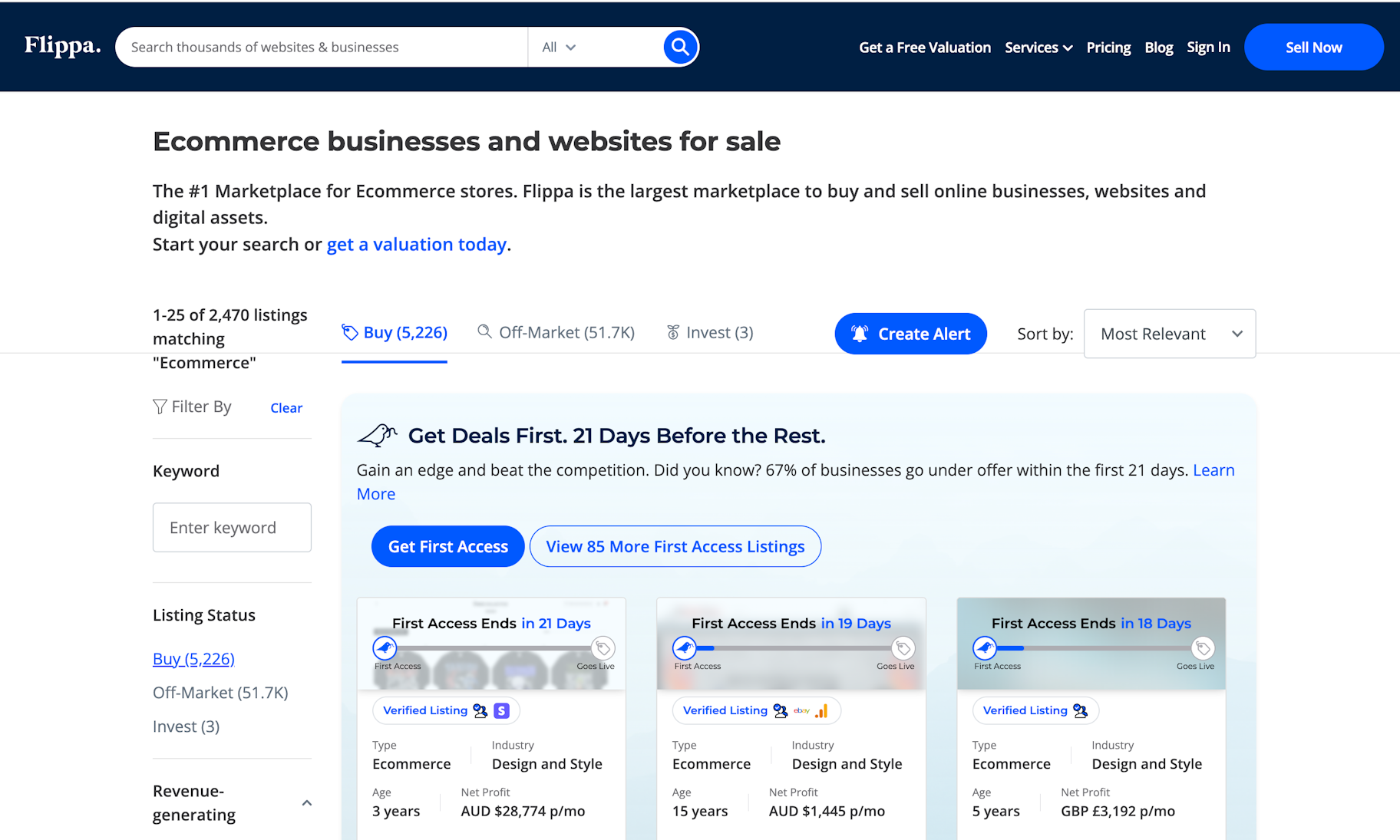
Flippa is a marketplace of websites for both people looking to invest in a fully functioning business and those who want to skip the building phase and start directly with marketing. Flippa has a great collection of online stores, including dropshipping ecommerce businesses, of varying price ranges and niches that you can choose from depending on your budget and interests.
So, if you’re looking for a dropshipping business for sale, Flippa has got you covered.
Factors to consider when buying a dropshipping store
When choosing to buy a store, take into account the cost, the design, the age of the website, how much money it has made, the popularity of the niche, penalizations, and the type of business.
Type of business
If you plan on buying a dropshipping business, you need to select the ecommerce filter on Flippa. Other options may require you to buy and hold inventory, which can cost more money over the long term, especially in unsold inventory.
Cost
Do you have a budget that covers not just the cost of a premade store but also allows for its growth? If so, you need to work out what your budget looks like. What price are you willing to pay for a business? Is there room to negotiate a better deal?
Design
Does the store look like it was designed by a professional or by a new entrepreneur who’s looking to make a quick sale? If the store design looks professional, clean, and easy to navigate, it may be worth pursuing.
Age of website
On Flippa, you can choose an ecommerce business based on its age. An older website will typically have a better chance of ranking online than a newer one.
Earnings
Sometimes you’ll see that a store made a lot of money. However, a question you need to ask is, “How much money was it making at its peak, and how much is it making now?” This will help you understand if the dropshipping business is growing or dying.
Niche popularity
You probably don’t want to be selling fidget spinners anymore, or any trending product. However, if a store is within an evergreen niche and sells trending products, it could work out well. Broad topics (beauty) tend to perform better than stores focused on a specific type of product (makeup brushes).
Penalizations
Before buying a dropshipping business, you need to double check that the website hasn’t been penalized (removed from Google’s search index). You can use a tool like Is My Website Penalized to determine if a website has been penalized by Google. If a store has been penalized it may be harder for you to rank in search engines. You also want to ask, “Were any of the business’s Facebook ads banned?”
Getting started with dropshipping
Whether you’re new or seasoned in business, dropshipping with Shopify is your low-risk gateway to online sales. Sign up, choose your plan, add DSers, and select your niche products. Customize, import, and sell—your ecommerce journey begins now.
How to start dropshipping FAQ
What are the benefits of starting a dropshipping business?
- Low risk
- Easy to start
- Wide selection of items to sell
- Flexible location
- Highly scalable
How do I start a dropshipping business?
- Choose a dropshipping business idea.
- Research your competitors.
- Find a reliable dropshipping supplier.
- Establish your online store.
- Market your dropshipping business.
- Assess and optimize your store.
Do I need to incorporate a dropshipping business?
Incorporating a dropshipping business has clear benefits. It separates your personal and business finances, protecting your money if the business runs into debt. Additionally, incorporating gets you an employer identification number (EIN), which makes it easier to file and pay sales tax. So if you’re planning for long-term success, think about incorporating. It’s a good way to manage your finances and taxes.
Is dropshipping really profitable?
Dropshipping can be a highly lucrative business, as it allows you to avoid the substantial overhead associated with traditional wholesaling. You bypass the costs of bulk purchases, storage, and shipping logistics—and can earn a good profit margin with the right suppliers.
Many dropshippers earn up to $50,000 per year as a side hustle. To hit such figures, you’ll need to pick the right suppliers and build a strong brand.
Keep in mind that dropshipping can be highly competitive. Because the barrier to entry is low, you may encounter numerous brands offering similar products at competitive prices.
Is dropshipping worth it?
The value of dropshipping depends on the time and money you invest in it. If you dedicate time to growing your online business, you are more likely to reap the rewards. Setting up a dropshipping business involves multiple steps: You need to set up a store, import products, decide on your pricing strategy, and start selling. All of this requires effort and commitment for your business to be successful.




